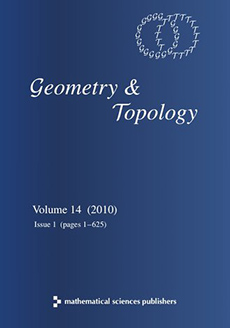Abstract
We describe a family of –dimensional hyperbolic orbifolds, constructed by deforming an infinite volume orbifold obtained from the ideal, hyperbolic –cell by removing two walls. This family provides an infinite number of infinitesimally rigid, infinite covolume, geometrically finite discrete subgroups of . It also leads to finite covolume Coxeter groups which are the homomorphic image of the group of reflections in the hyperbolic –cell. The examples are constructed very explicitly, both from an algebraic and a geometric point of view. The method used can be viewed as a –dimensional, but infinite volume, analog of –dimensional hyperbolic Dehn filling.
Citation
Steven P Kerckhoff. Peter A Storm. "From the hyperbolic $24$–cell to the cuboctahedron." Geom. Topol. 14 (3) 1383 - 1477, 2010. https://doi.org/10.2140/gt.2010.14.1383
Information





